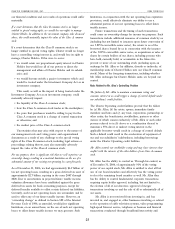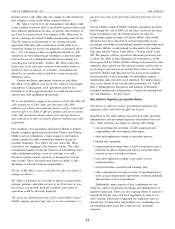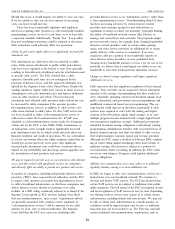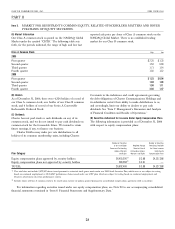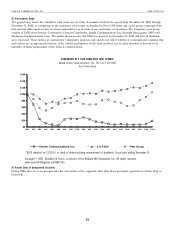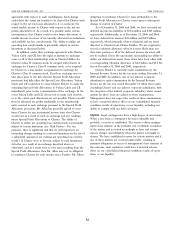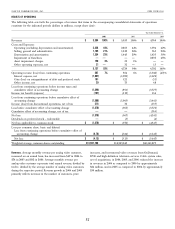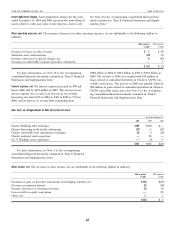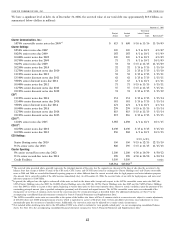Charter 2006 Annual Report Download - page 47
Download and view the complete annual report
Please find page 47 of the 2006 Charter annual report below. You can navigate through the pages in the report by either clicking on the pages listed below, or by using the keyword search tool below to find specific information within the annual report.
CHARTER COMMUNICATIONS, INC. 2006 FORM 10-K
(Verifying the integrity of the customer’s network connec- method over management’s estimate of the estimated useful
tion by initiating test signals downstream from the headend lives of the related assets as listed below:
to the customer’s digital set-top box.
Cable distribution systems 7-20 years
Judgment is required to determine the extent to which Customer equipment and installations 3-5 years
overhead costs incurred result from specific capital activities, and Vehicles and equipment 1-5 years
Buildings and leasehold improvements 5-15 years
therefore should be capitalized. The primary costs that are Furniture, fixtures and equipment 5 years
included in the determination of the overhead rate are
(i) employee benefits and payroll taxes associated with capital- Impairment of property, plant and equipment, franchises and goodwill.
ized direct labor, (ii) direct variable costs associated with As discussed above, the net carrying value of our property, plant
capitalizable activities, consisting primarily of installation and and equipment is significant. We also have recorded a significant
construction vehicle costs, (iii) the cost of support personnel, amount of cost related to franchises, pursuant to which we are
such as dispatchers, who directly assist with capitalizable granted the right to operate our cable distribution network
installation activities, and (iv) indirect costs directly attributable throughout our service areas. The net carrying value of
to capitalizable activities. franchises as of December 31, 2006 and 2005 was approximately
While we believe our existing capitalization policies are $9.2 billion (representing 61% of total assets) and $9.8 billion
appropriate, a significant change in the nature or extent of our (representing 60% of total assets), respectively. Furthermore, our
system activities could affect management’s judgment about the noncurrent assets include approximately $61 million of goodwill.
extent to which we should capitalize direct labor or overhead in We adopted SFAS No. 142, Goodwill and Other Intangible
the future. We monitor the appropriateness of our capitalization Assets, on January 1, 2002. SFAS No. 142 requires that franchise
policies, and perform updates to our internal studies on an intangible assets that meet specified indefinite-life criteria no
ongoing basis to determine whether facts or circumstances longer be amortized against earnings, but instead must be tested
warrant a change to our capitalization policies. We capitalized for impairment annually based on valuations, or more frequently
internal direct labor and overhead of $204 million, $190 million as warranted by events or changes in circumstances. In
and $164 million, respectively, for the years ended December 31, determining whether our franchises have an indefinite-life, we
2006, 2005, and 2004. Capitalized internal direct labor and considered the likelihood of franchise renewals, the expected
overhead costs have increased in 2005 and 2006 as compared to costs of franchise renewals, and the technological state of the
2004 as a result of the use of more internal labor for associated cable systems, with a view to whether or not we are
capitalizable installations, rather than third party contractors. in compliance with any technology upgrading requirements
specified in a franchise agreement. We have concluded that as
Useful lives of property, plant and equipment. We evaluate the of December 31, 2006, 2005, and 2004 more than 99% of our
appropriateness of estimated useful lives assigned to our prop- franchises qualify for indefinite-life treatment under
erty, plant and equipment, based on annual analyses of such SFAS No. 142, and that less than one percent of our franchises
useful lives, and revise such lives to the extent warranted by do not qualify for indefinite-life treatment, due to technological
changing facts and circumstances. Any changes in estimated or operational factors that limit their lives. Costs of finite-lived
useful lives as a result of these analyses, which were not franchises, along with costs associated with franchise renewals,
significant in the periods presented, will be reflected prospec- are amortized on a straight-line basis over 10 years, which
tively beginning in the period in which the study is completed. represents management’s best estimate of the average remaining
The effect of a one-year decrease in the weighted average useful lives of such franchises. Franchise amortization expense
remaining useful life of our property, plant and equipment was $2 million, $4 million, and $3 million for the years ended
would be an increase in depreciation expense for the year ended December 31, 2006, 2005, and 2004, respectively. We expect
December 31, 2006 of approximately $168 million. The effect of that amortization expense on franchise assets will be approxi-
a one-year increase in the weighted average useful life of our mately $1 million annually for each of the next five years.
property, plant and equipment would be a decrease in deprecia- Actual amortization expense in future periods could differ from
tion expense for the year ended December 31, 2006 of these estimates as a result of new intangible asset acquisitions or
approximately $131 million. divestitures, changes in useful lives, and other relevant factors.
Depreciation expense related to property, plant and equip- Our goodwill is also deemed to have an indefinite life under
ment totaled $1.3 billion, $1.4 billion, and $1.4 billion, represent- SFAS No. 142.
ing approximately 26%, 30%, and 21% of costs and expenses, for SFAS No. 144, Accounting for Impairment or Disposal of Long-
the years ended December 31, 2006, 2005, and 2004, respec- Lived Assets, requires that we evaluate the recoverability of our
tively. Depreciation is recorded using the straight-line composite property, plant and equipment and franchise assets which did
not qualify for indefinite-life treatment under SFAS No. 142,
upon the occurrence of events or changes in circumstances
which indicate that the carrying amount of an asset may not be
recoverable. Such events or changes in circumstances could
include such factors as the impairment of our indefinite-life
33


